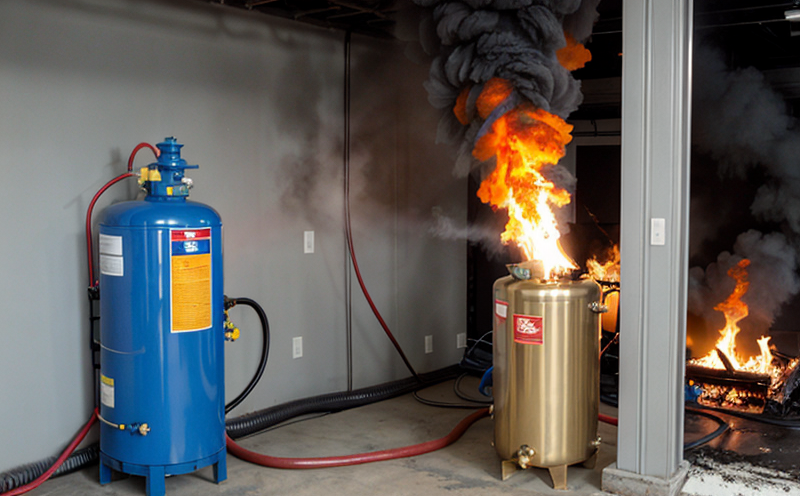Fire Extinguisher Refill and Recharge Verification
In fire safety testing, ensuring that fire extinguishers are in optimal working condition is paramount. A critical aspect of this maintenance involves the refill and recharge verification process. This service ensures that all components of a fire extinguisher meet the required standards to deliver effective suppression performance when needed.
The refill and recharge verification process primarily focuses on the recharging of the extinguishing agent, the integrity of the cylinder, and the operational readiness of the nozzle and other accessories. This procedure is essential for maintaining compliance with national and international fire safety regulations such as NFPA 10, ISO 9692, and EN 3.
The testing process begins by inspecting the extinguisher to ensure that it has not been compromised in any way that would affect its performance. The next step involves a thorough examination of the cylinder's integrity through hydrostatic testing. This ensures that the pressure vessel remains intact under specified conditions, which is crucial for containing and releasing the extinguishing agent safely.
The recharging process itself can vary depending on the type of extinguisher. For example, water-based extinguishers are refilled with fresh water, while CO2 units require the replacement or recharge of CO2 gas cylinders. Dry chemical extinguishers may need a replacement of the powder charge, and clean agent extinguishers might necessitate a refill of the halocarbon compound.
The verification process also includes checking for any signs of corrosion on the cylinder walls, which can indicate potential weaknesses that could compromise safety during use. Any defects are documented and addressed accordingly to ensure compliance with relevant standards.
For the nozzle and other operational components, a functional test is conducted to simulate real-world conditions under which the extinguisher might be used. This ensures that all parts of the extinguisher work together seamlessly as intended. The results of this test are compared against established performance criteria outlined in NFPA 10, ensuring that the fire suppression system meets or exceeds these benchmarks.
In addition to the physical inspection and testing, documentation plays a crucial role in the refill and recharge verification process. Detailed records are kept throughout the entire procedure, including any repairs, replacements, or adjustments made during the service. These documents serve as proof of compliance with fire safety regulations and provide valuable information for future maintenance activities.
The importance of this service cannot be overstated, especially in high-risk environments such as industrial facilities, commercial buildings, and public spaces where fire hazards are present. By ensuring that all fire extinguishers are properly maintained through refill and recharge verification, organizations can significantly enhance their overall safety profile and comply with regulatory requirements.
Regular testing and maintenance of fire extinguishers contribute to a safer environment by preventing potential risks associated with outdated or malfunctioning equipment. This proactive approach not only helps in meeting legal obligations but also protects the interests of stakeholders such as employees, customers, and visitors who rely on these safety measures.
Benefits
- Ensures compliance with NFPA, ISO, and EN standards for fire safety systems.
- Reduces the risk of accidental discharge due to compromised cylinders or components.
- Maintains operational readiness by simulating real-world conditions during functional tests.
- Avoids potential legal liabilities associated with non-compliant fire suppression equipment.
- Extends the lifespan of fire extinguishers through timely maintenance and proper recharging.
- Enhances overall safety in high-risk environments by ensuring all systems are in optimal working condition.
Quality and Reliability Assurance
The quality assurance process for fire extinguisher refill and recharge verification is robust, involving multiple steps to ensure reliability. Initial inspections involve visual checks of the cylinder, nozzle, and other components to identify any visible signs of damage or wear. The hydrostatic testing then confirms the structural integrity of the extinguisher by subjecting it to pressure within specified limits.
During recharging, all chemical agents are replaced with fresh materials that meet stringent quality control checks. This includes verifying the purity and concentration levels of the agent according to manufacturer specifications. For gas cylinders, the replacement or recharging process adheres strictly to guidelines set forth by relevant standards.
The functional testing conducted after refill and recharge verification ensures that all components operate correctly under simulated conditions. This includes checking for leaks in the cylinder, proper release of the extinguishing agent, and smooth operation of the nozzle. Any discrepancies are immediately addressed to guarantee reliability.
Documentation plays a pivotal role in maintaining quality and reliability standards. Detailed records are kept throughout each step of the process, including any adjustments or repairs made during maintenance. These documents serve as a comprehensive audit trail that can be referenced for future reference or inspection purposes.
Customer Impact and Satisfaction
The impact of fire extinguisher refill and recharge verification on customers is profound, particularly in terms of safety assurance. By ensuring that all fire suppression systems are compliant with established standards, organizations can significantly reduce the risk of fires occurring within their premises.
Customers benefit from a safer environment where they know that critical safety measures are always up to date and functioning correctly. This peace of mind is essential in environments such as commercial offices, retail spaces, manufacturing plants, and public venues. The proactive approach taken by organizations in maintaining these systems contributes positively towards enhancing customer satisfaction.
The reliability of fire extinguishers directly affects the confidence level of customers using these facilities. Knowing that all safety measures are regularly inspected and maintained boosts trust and fosters a positive perception of the organization providing these services. This can lead to improved brand reputation and enhanced customer loyalty over time.





